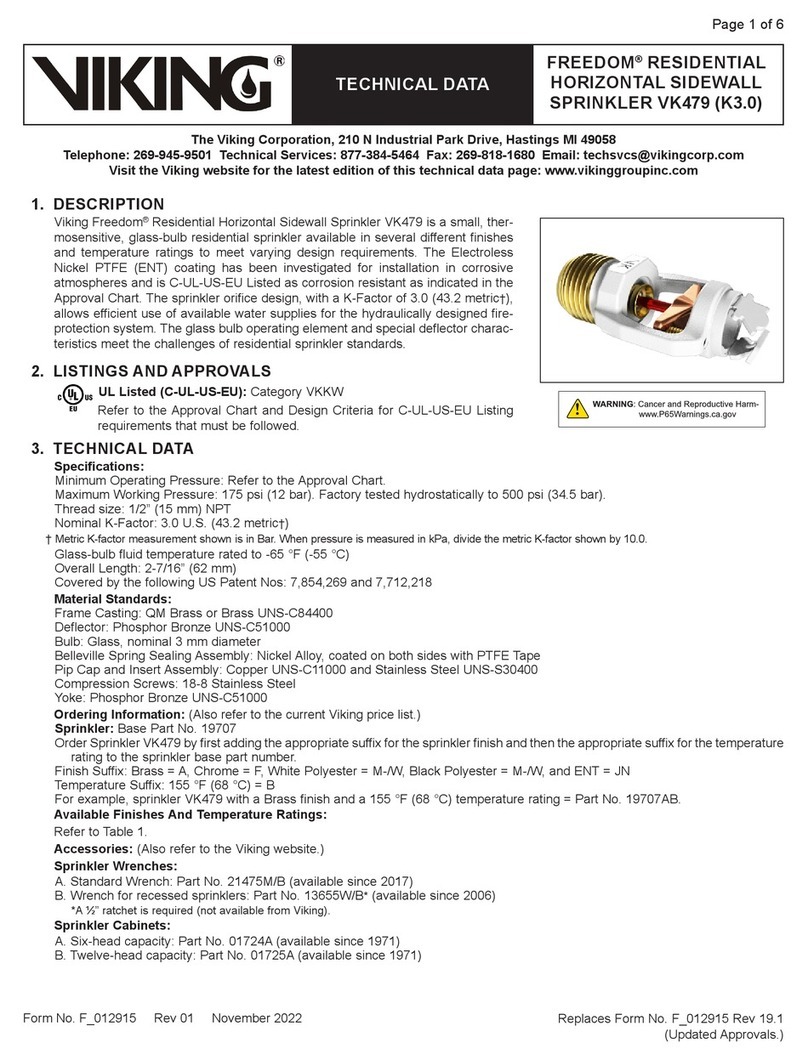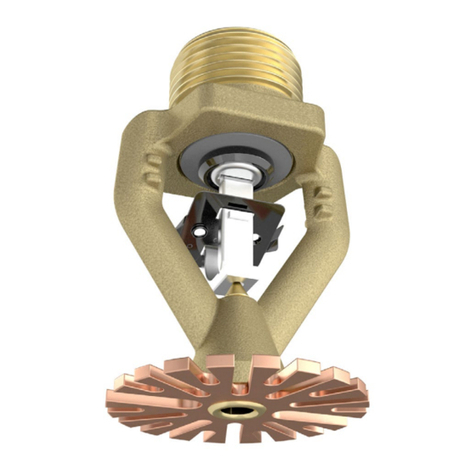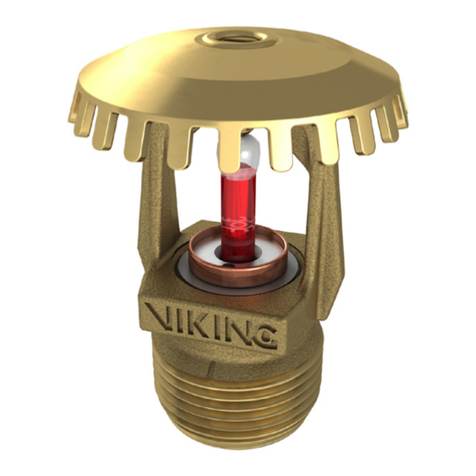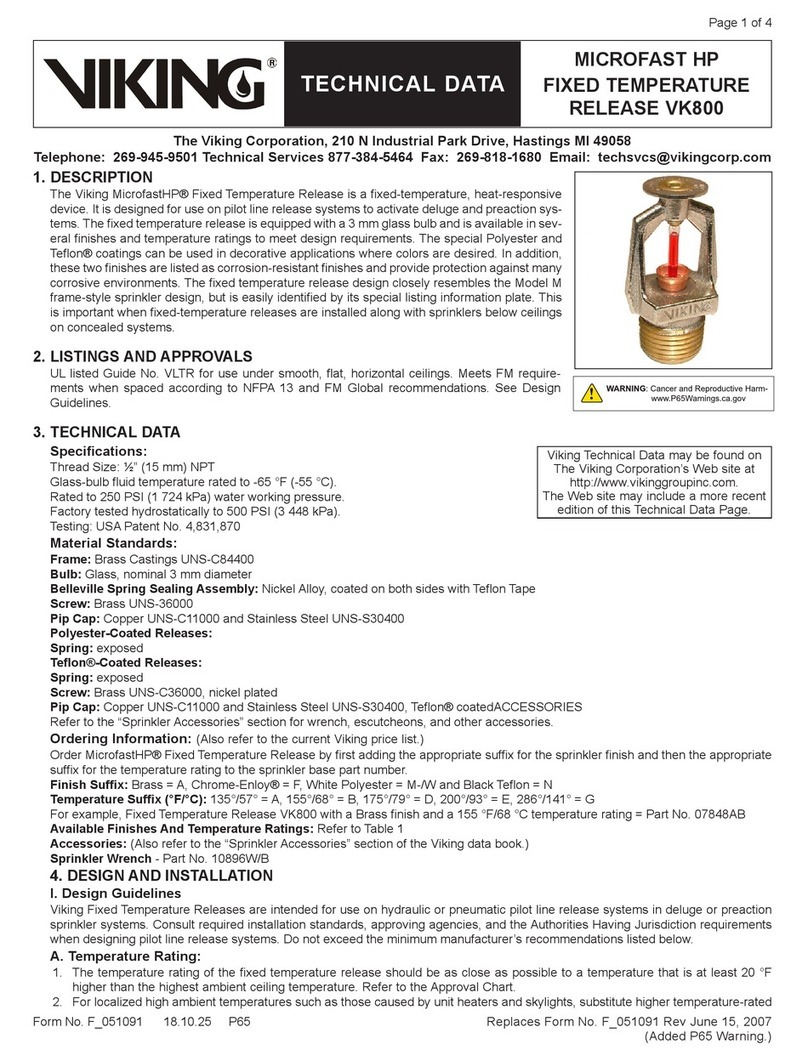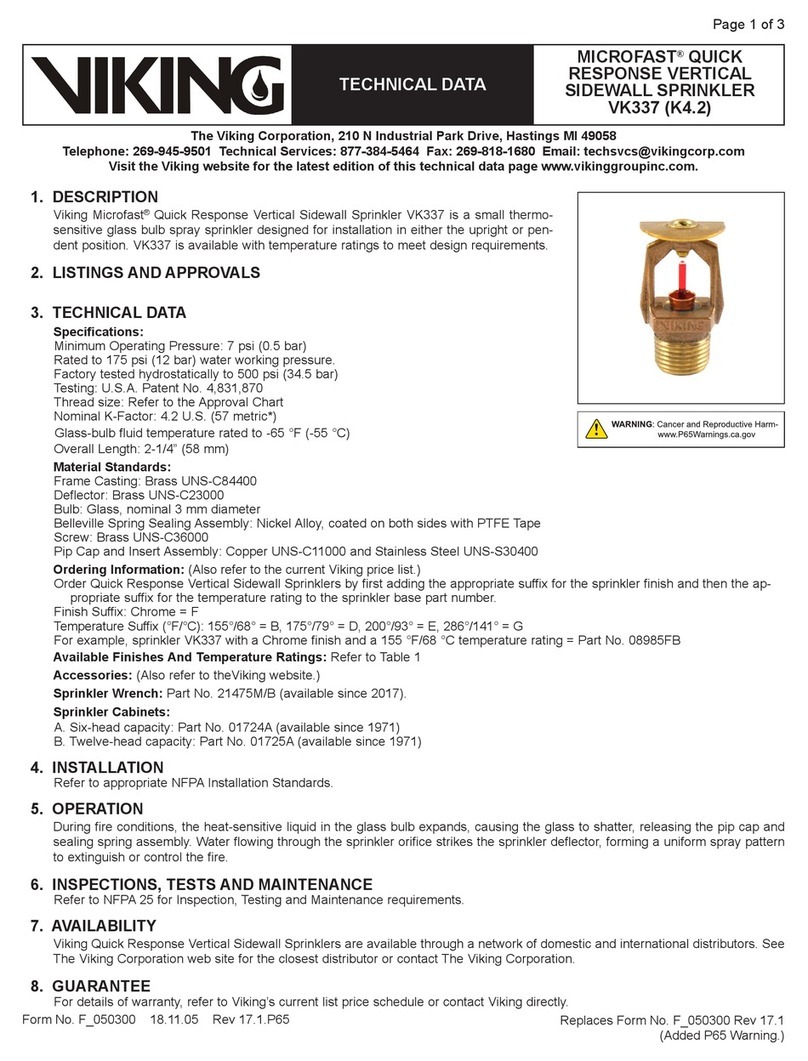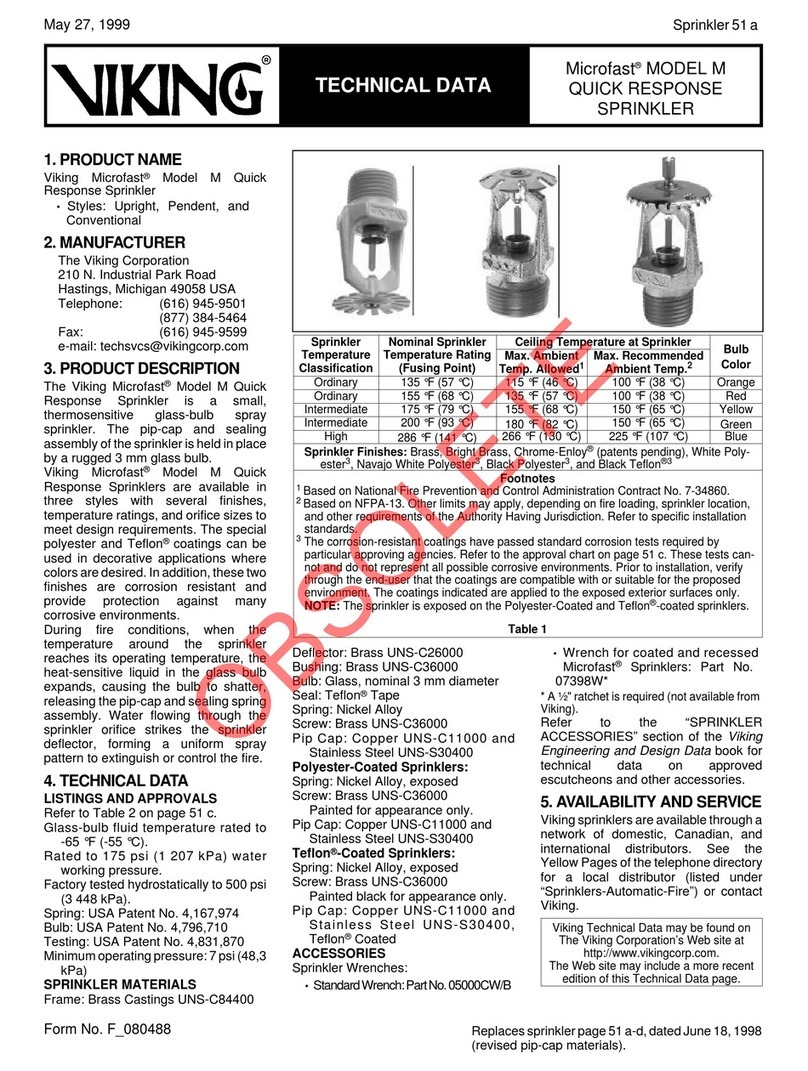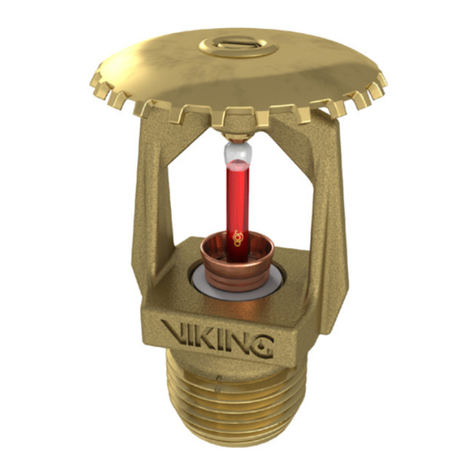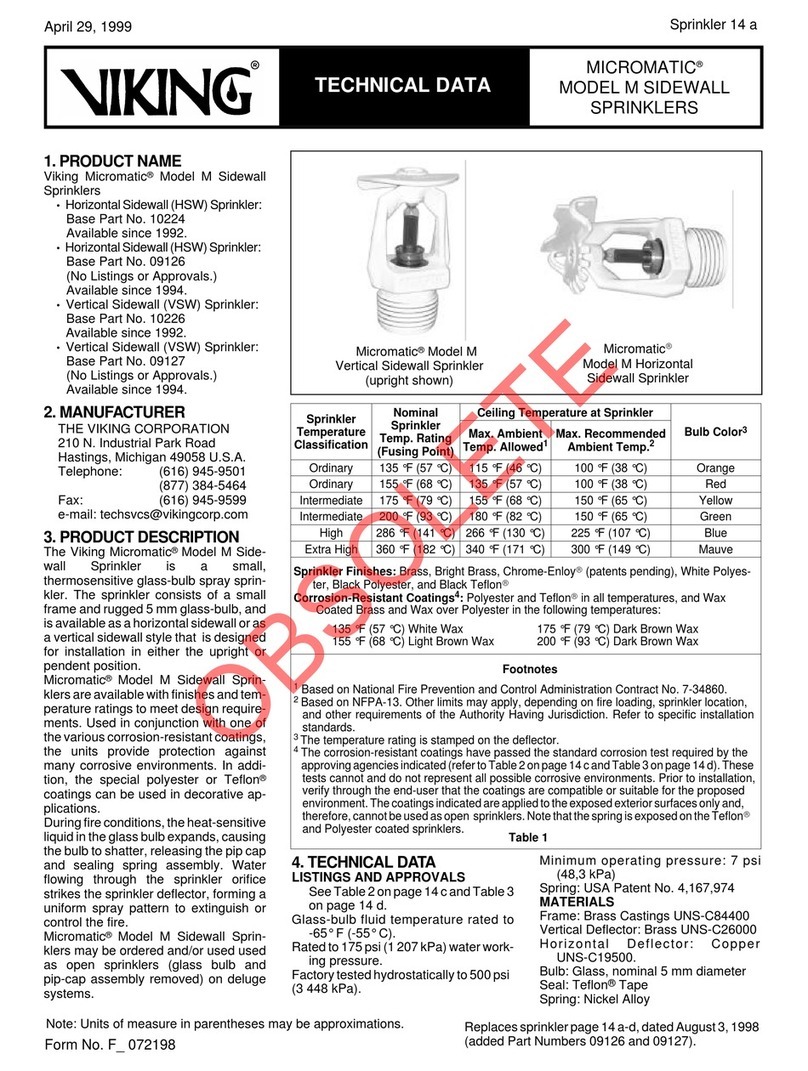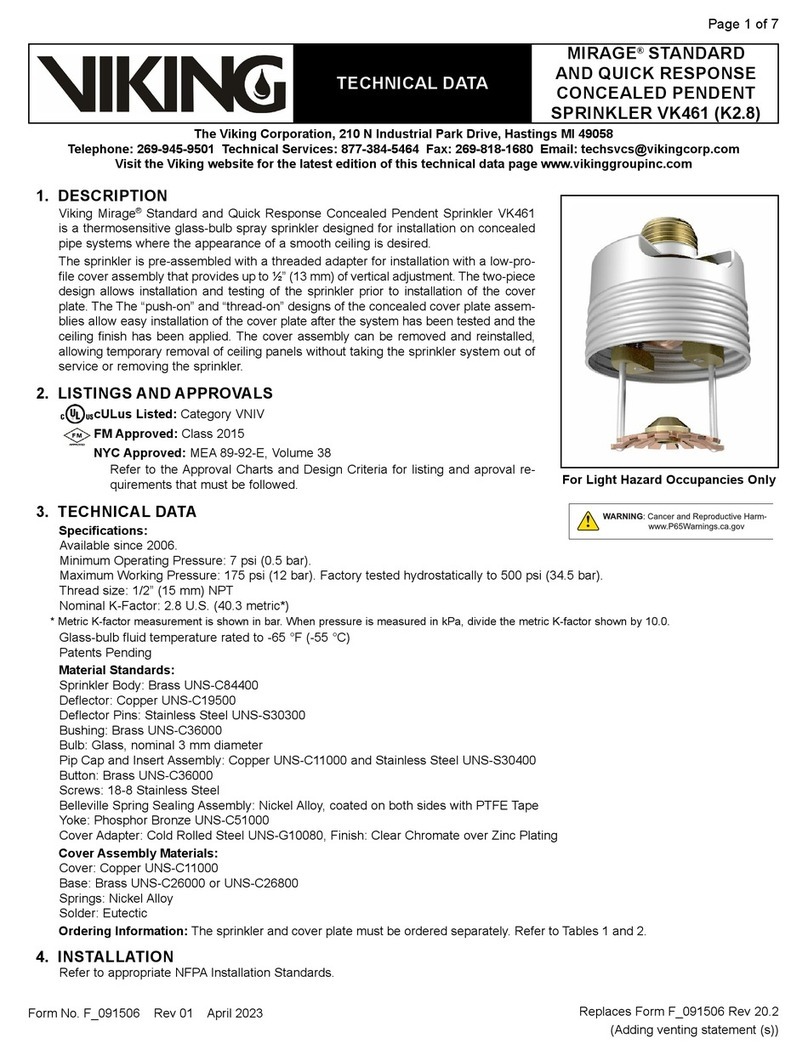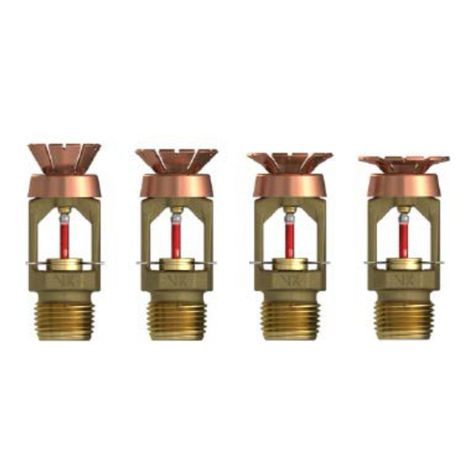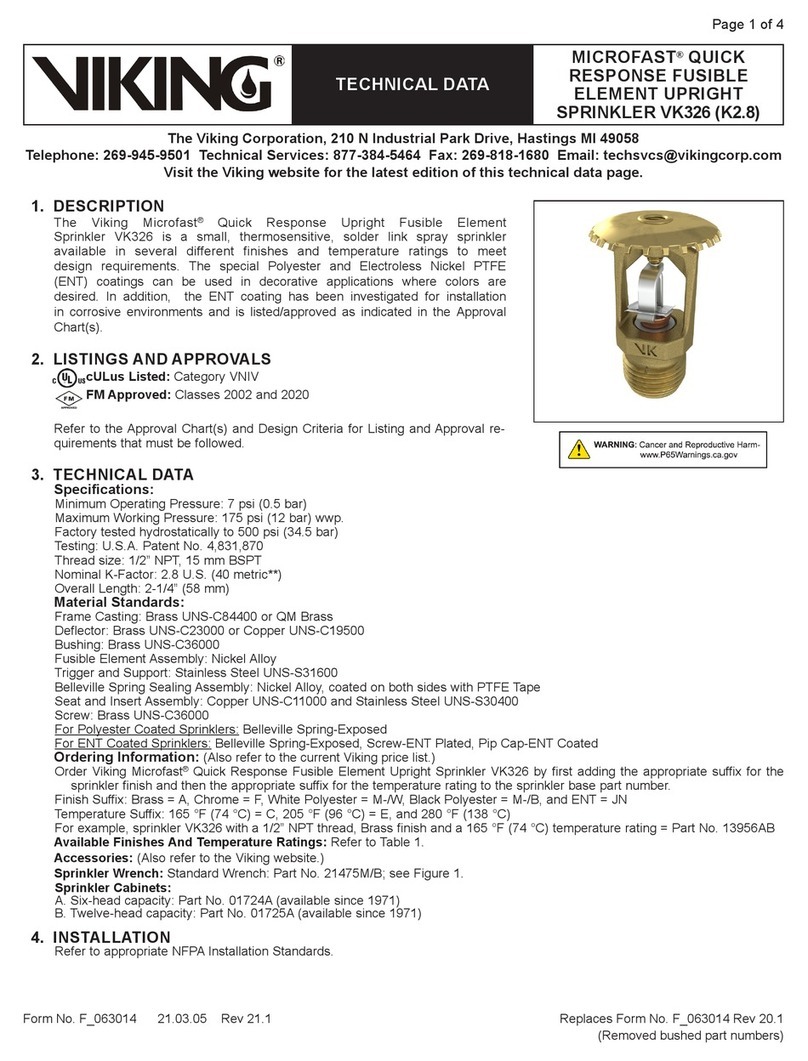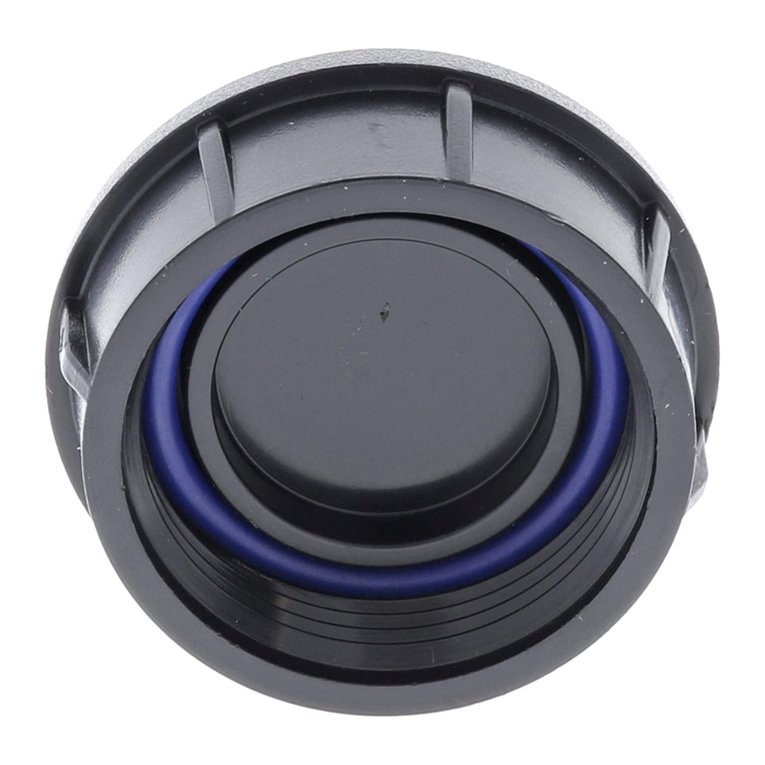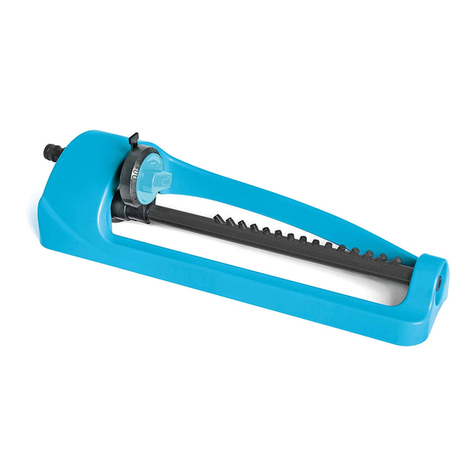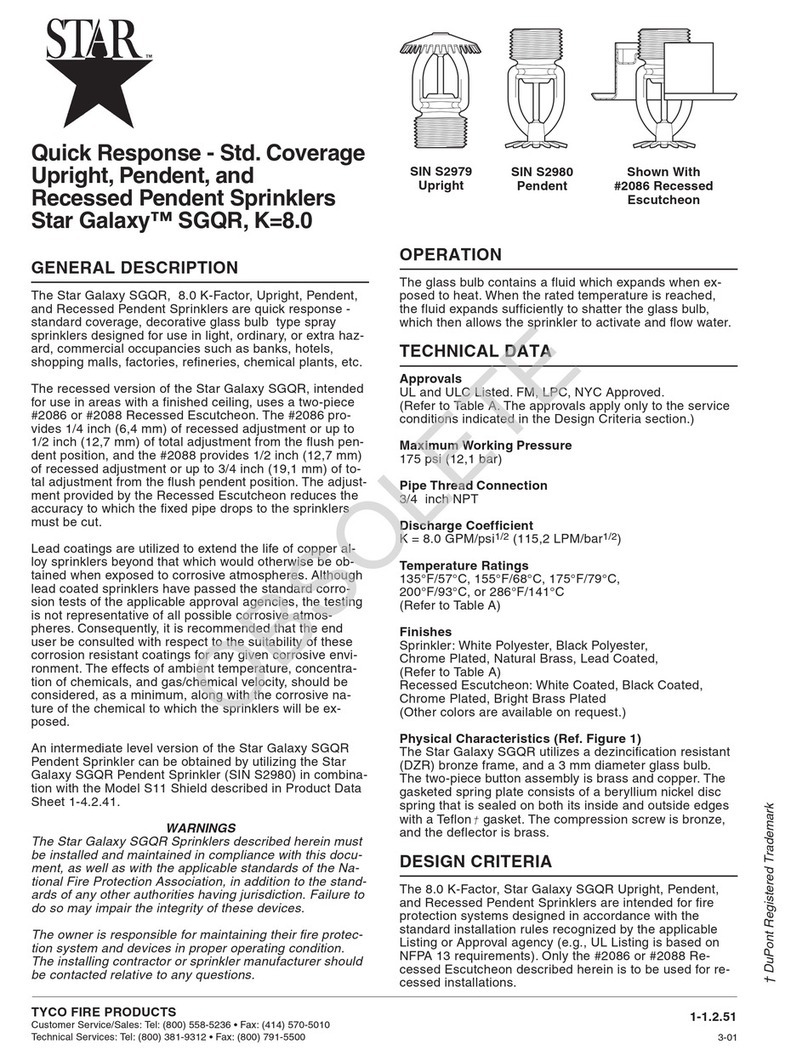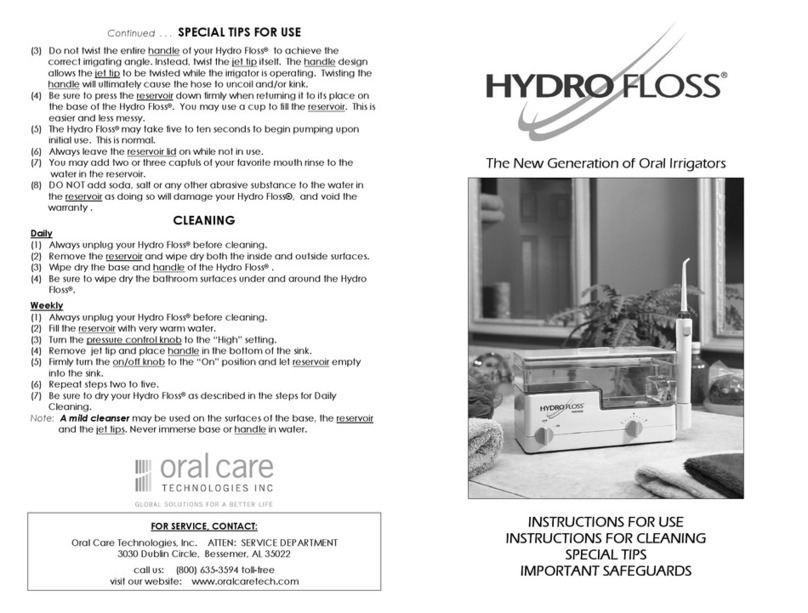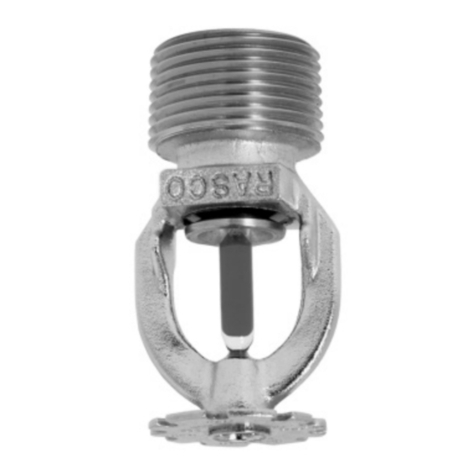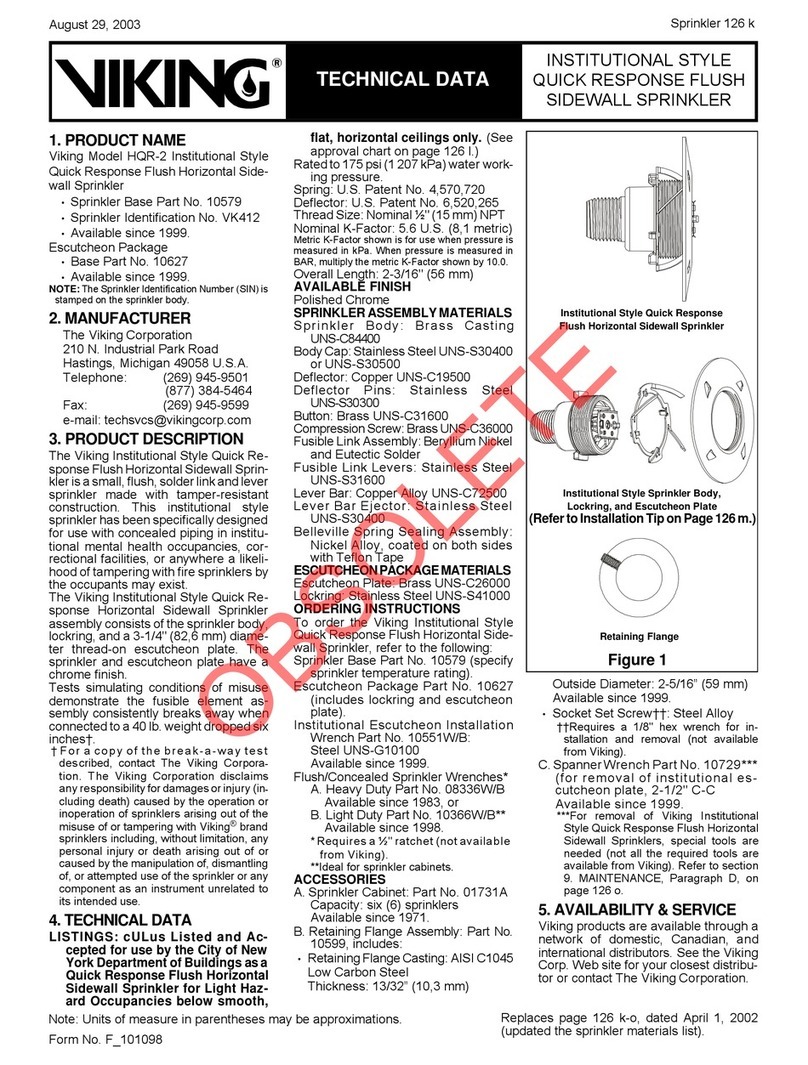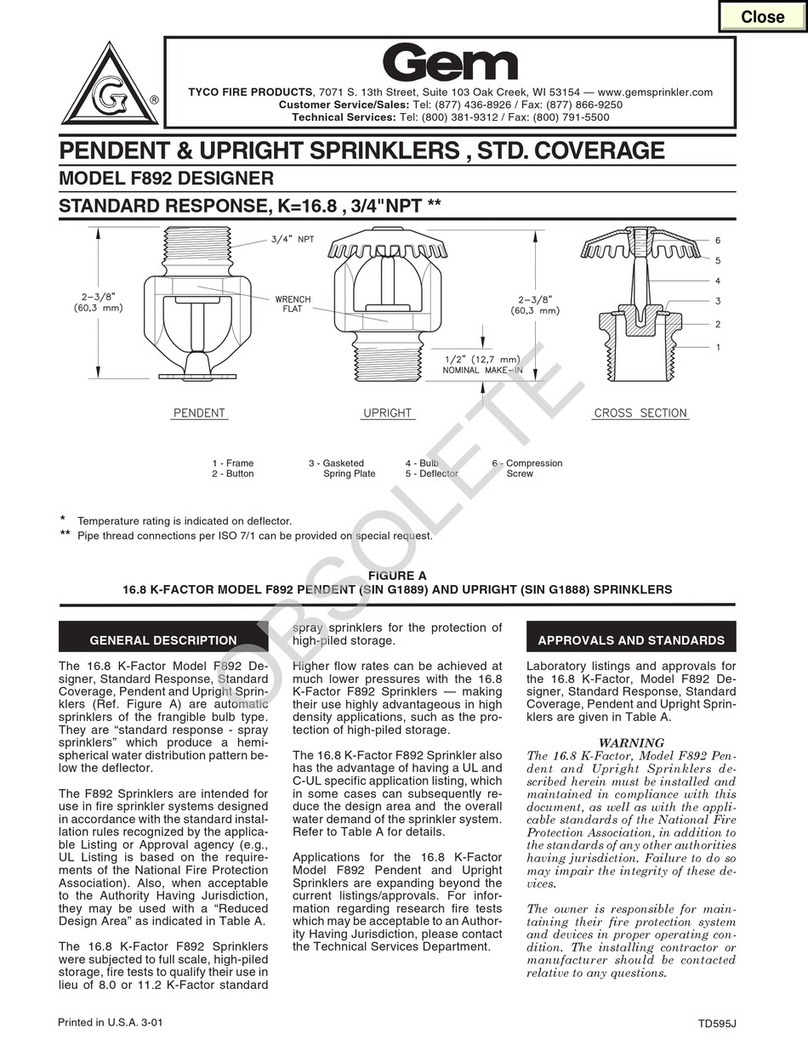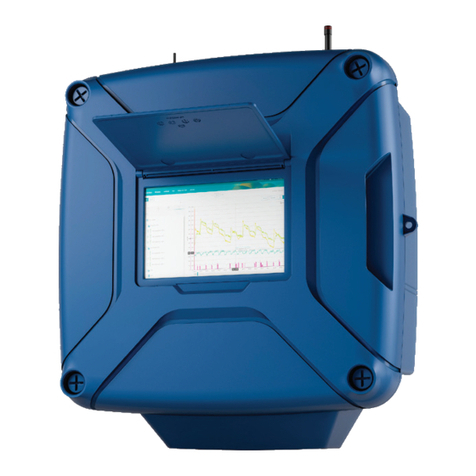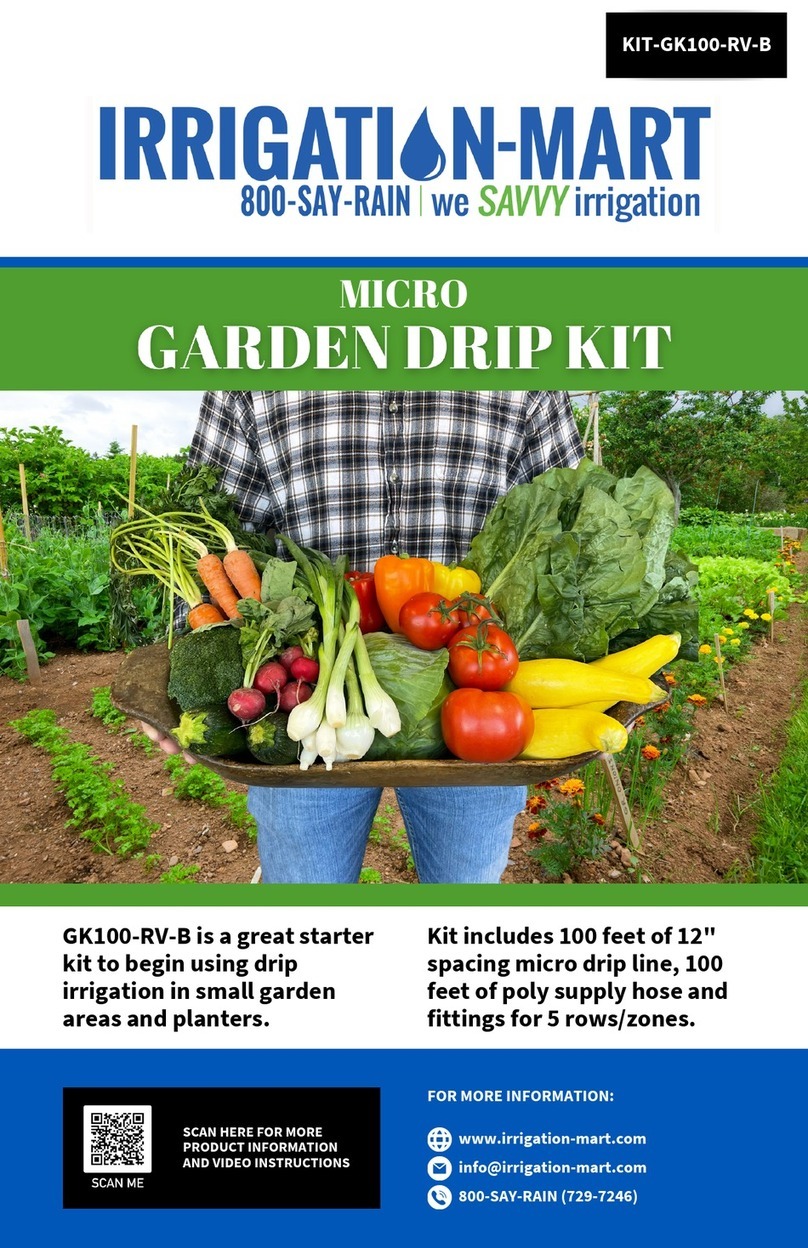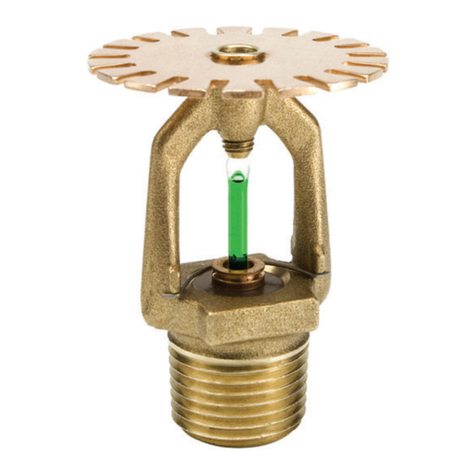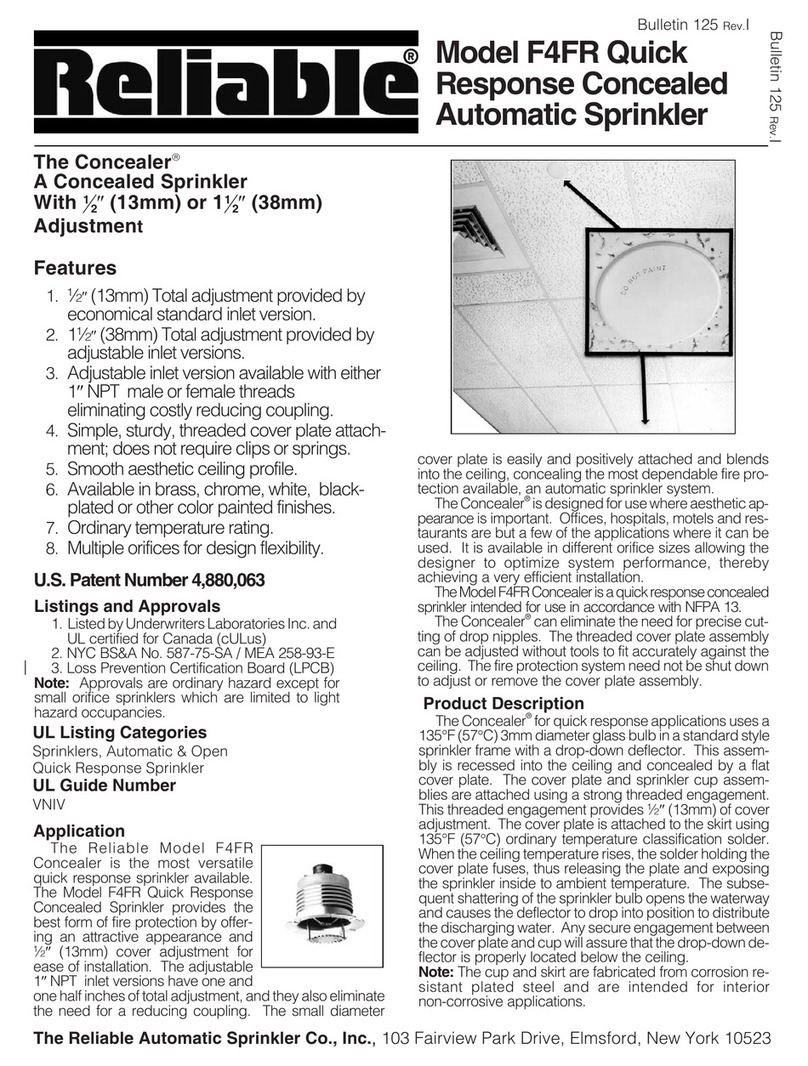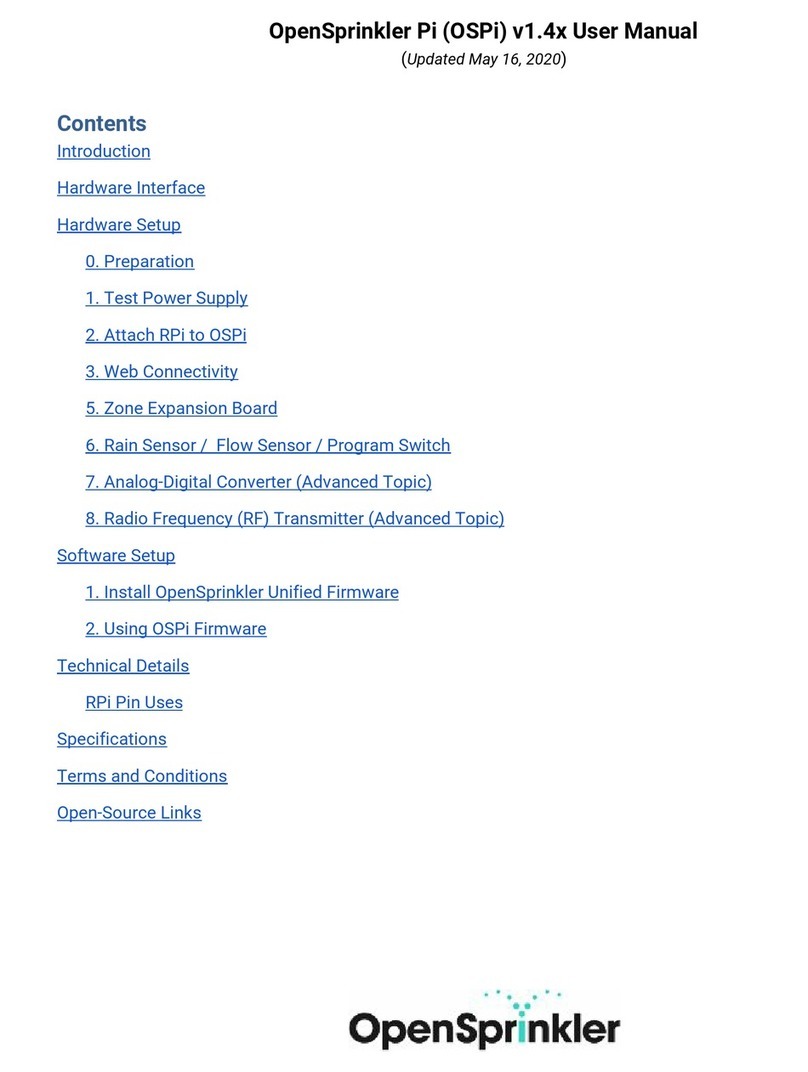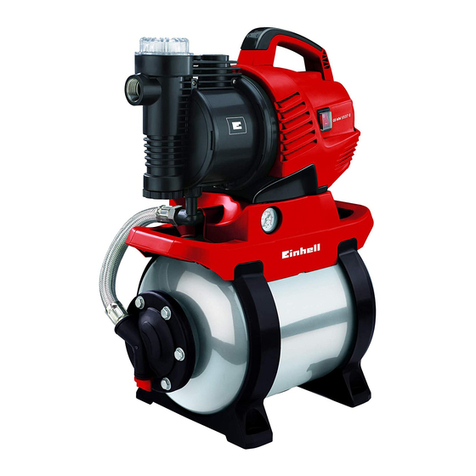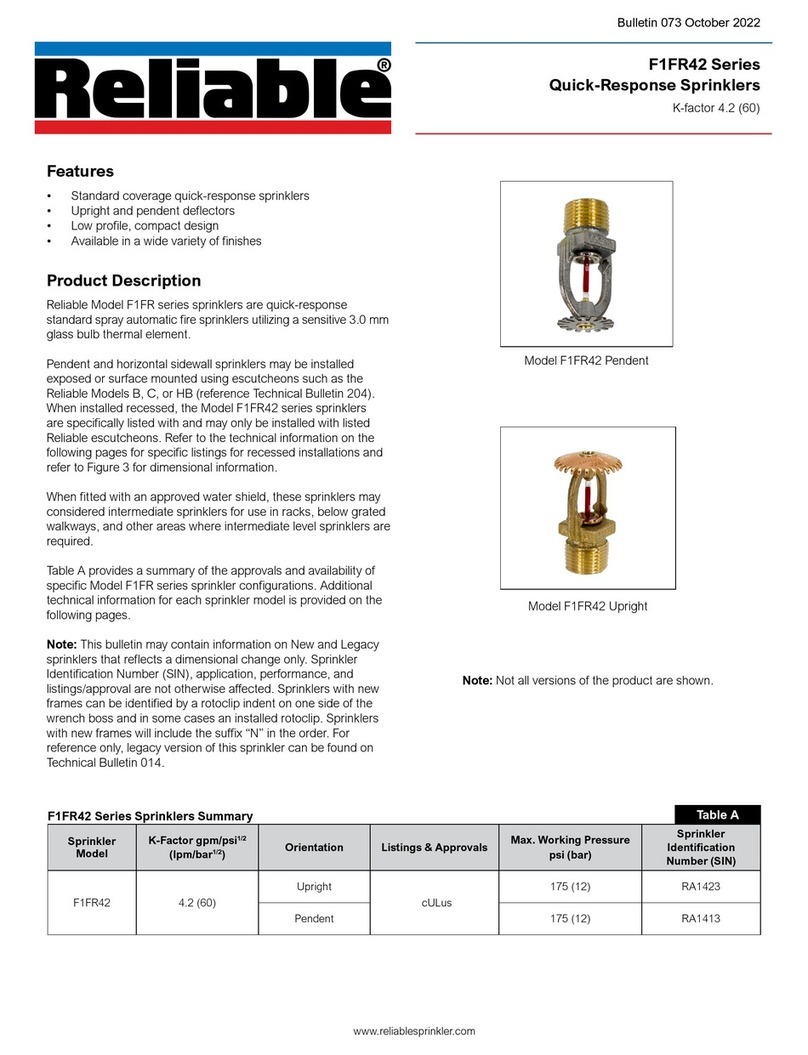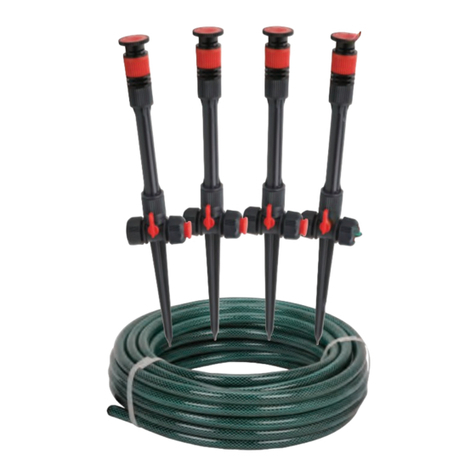
necessary,replaced after a specified
term of service. Refer to the installa-
tion standards and the Authority Hav-
ing Jurisdiction for the specified pe-
riod of time after which testingand/or
replacement is required. Sprinklers
that have operated cannot be reas
-
sembled or reused, but must be re-
placed. When replacing sprinklers,
use only new sprinklers.
C. The sprinkler discharge pattern is
critical for proper fire protection.
Nothing should be hung from the
sprinkler, attached to it, or otherwise
obstruct the discharge pattern. All
obstructions must be immediately re-
moved or, if necessary, additional
sprinklers installed.
D. When replacingexisting sprinklers,the
systemmustberemoved from service.
Refer to the appropriate system de
-
scription and/or valve instructions.
Prior to removing the system from ser-
vice, notify all AHJs. Consideration
should be given to employment of a
fire patrol in the affected area.
DISASSEMBLY: There are two meth
-
ods of sprinkler disassembly. In Method
1, the escutcheon plate and lockring
areremovedfirst, and then the remain-
ing sprinkler components can be re-
moved without being destroyed. The
second method of disassemblyresults
in complete destruction of the unit.
Disassembly Method 1:
1. Remove the system from service,
drain all water, and relieve all
pressure on the piping.
2. Use a drill (not available from Vi
-
king) sized appropriately for use
with a spanner wrench (see step
3) to make two holes through two
opposite indentations on the face
of the escutcheon plate.
3. Use a 2-1/2" C-C spanner wrench
(Viking P/N 10729) to unthread
the escutcheon plate by turning it
counterclockwise. Make sure that
the sprinkler body does not turn or
loosen.
4. Remove the lockring from the
sprinkler body.
5. Place a protective sprinkler shell
(from the spare sprinkler cabinet)
overthesprinklertoberemoved.
6. With the protective shell over the
sprinkler, place the special Flush/
Concealed Sprinkler Wrench over
the unit and turn it counterclockwise
to carefully unthread the sprinkler
body from the reducing coupling.
7.Install the new unit using the Flush/
Concealed Sprinkler Wrench.
Care must be taken to ensure that
the replacement sprinkler is the
proper model and style, with the
appropriate orifice size, tempera-
ture rating, and response charac
-
teristics. A fully stocked spare
sprinkler cabinet should be pro-
vided for this purpose. (Stock of
spare lockrings and escutcheon
plates should be available in the
spare sprinkler cabinet in addition
to the spare sprinkler heads.)
8. Place the system back in service
and secure all valves. Check for
and repair all leaks.
Disassembly Method 2:
1. Remove the system from service,
drain all water, and relieve all
pressure on the piping.
2. Disassemble and remove the fus-
ible element, and bend the deflec-
tor and sealing assembly to ex-
pose the waterway of the sprin
-
kler.
3. Insert an easy-out screw extractor
(Trade No. 6) into the waterway.
Turn the easy-out counterclock-
wise with a wrench to remove the
sprinkler assembly from the re-
ducing coupling.
4. Install the new unit using the
Flush/Concealed Sprinkler Wrench.
Care must be taken to ensure that
the replacement sprinkler is the
proper model and style, with the
appropriate orifice size, tempera
-
ture rating, and response charac-
teristics. A fully stocked spare
sprinkler cabinet should be pro-
vided for this purpose. (Stock of
spare lockrings and escutcheon
plates should be available in the
spare sprinkler cabinet in addition
to the spare sprinkler heads.)
5. Place the system back in service
and secure all valves. Check for
and repair all leaks.
E. Sprinkler systems that have been
subject to a fire must be returned to
service as soon as possible. The en
-
tire system must be inspected for
damage and repaired or replaced as
necessary. Sprinklers that have
been exposed to corrosive products
of combustion or high ambient tem
-
peratures, but have not operated,
should be replaced. Refer to the Au
-
thority Having Jurisdiction for mini-
mum replacement requirements.
Sprinkler 126 d
Form No. F_100998
NOTE: This method of
disassembly results in damage to
the escutcheon plate and lockring,
and they cannot be reused.
NOTE: This method of disassembly
results in complete destruction
of the unit. None of the sprinkler
components may be reused.
TECHNICAL DATA
Sprinkler Temperature
Classification Nominal Temperature
Rating (Fusing Point) Maximum Ambient
Ceiling Temperature1,2
Ordinary 165 °F (74 °C) 100 °F (38 °C)
Intermediate 220 °F (104 °C) 150 °F (66 °C)
Approval Chart
Institutional QR Flush Pendent Sprinkler
Thread Size Orifice
Size Nominal K-Factor Overall Length Sprinkler Base
Part No.3SIN
NPT BSP U.S.8metric4Inches mm
½" 15 mm Standard 5.6 8,1 2-9/32 57,9 10554 VK410
Standard Coverage Applications
Refer to minimum flow and pressure requirements
as specified in current NFPA Standards.
Listings5,6
cULus8FM NYC LPCB
A1 –B19–
Extended Coverage Applications
For Light Hazard Occupancies Only
Maximum Area of Coverage:
16' Wide x 16' Throw (4,9 m x 4,9 m)
Minimum Water Supply Requirements:
26 gpm @ 21.6 psi (98,4 L/min @ 148,6 kPa)
Listings5,7
cULus8FM NYC LPCB
A1 – – –
Temperature Ratings
A - 165 °F (74 °C) and 220 °F (104 °C)
B - 165 °F (74 °C) only
Available Finish
1 - Polished Chrome
1Based on NFPA-13. Other limits may apply, depending on fire loading, sprinkler location, and
other requirements of the AHJ. Refer to specific installation standards.
2 The temperature rating is stamped on the sprinkler.
3Base part number is shown. For complete part number, see Viking's current price list.
4Metric K-Factor shown is for use when pressure is measured in kPa. When pressure is mea-
sured in BAR, multiply the metric K-Factor shown by 10.0.
5This table shows the listings and approvals available at the time of printing. Other approvals
may be in process. Check with the manufacturer for any additional approvals.
6cULus Listed as a Quick Response Flush Pendent Sprinkler for standard areas of coverage.
7cULus Listed as a Quick Response Extended Coverage Flush Pendent Sprinkler for Light
Hazard occupancies only.
8Listed by Underwriters Laboratories Inc. for use in the U.S. and Canada.
9Accepted for use, City of New York Department of Buildings, MEA 89-92-E, Vol 16.
INSTITUTIONAL QUICK RESPONSE
STANDARD COVERAGE/
EXTENDED COVERAGE FLUSH
PENDENT SPRINKLER
Temperature Rating
Available Finish KEY
A1
Replaces page 126 a-d, dated August 8, 2002
(updated the sprinkler materials list).
December20,2002

